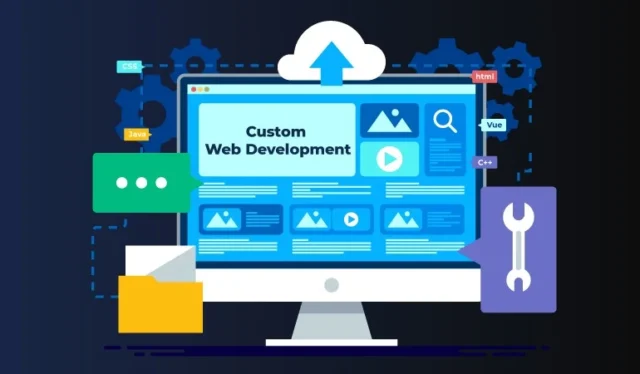In today’s digital landscape, having a website is essential for businesses, organizations, and individuals alike. While many opt for pre-built templates or platforms, developing a custom website offers distinct advantages, including tailored functionality, enhanced branding, and improved user experience. This blog will guide you through the steps to develop a custom website that meets your specific needs.

1. Define Your Goals and Objectives
Before diving into development, it’s crucial to clearly define your website’s goals and objectives. Ask yourself:
- What is the primary purpose of the website? (e.g., e-commerce, portfolio, blog, informational)
- Who is your target audience?
- What actions do you want users to take on your site? (e.g., make a purchase, sign up for a newsletter, contact you)
Having clear objectives will guide the design and development process and help you create a site that aligns with your vision.
2. Conduct Market Research
Understanding your competitors and industry trends can provide valuable insights as you develop your website. Analyze the following:
- Competitor Websites: Look at the strengths and weaknesses of competitors’ websites. Identify features or design elements that resonate with your target audience.
- User Preferences: Conduct surveys or interviews with potential users to gather insights into their preferences and expectations. This information will help you design a site that meets their needs.
3. Create a Sitemap and Wireframes
A sitemap outlines the structure of your website, detailing the main pages and their relationships. Creating a sitemap helps you visualize the site’s layout and navigation. Once you have a sitemap, develop wireframes to represent the basic layout of each page. Wireframes should include:
- Navigation elements
- Content placement
- Call-to-action buttons
This step provides a blueprint for your website, ensuring a logical flow and user-friendly experience.
4. Choose the Right Technology Stack
Selecting the right technology stack is crucial for developing a custom website. Consider the following components:
- Front-End Development: Choose technologies for the user interface, such as HTML, CSS, and JavaScript frameworks (e.g., React, Angular, or Vue.js).
- Back-End Development: Select a server-side language and framework (e.g., PHP, Python, Ruby on Rails, or Node.js) for handling data and server interactions.
- Database Management: Choose a database system (e.g., MySQL, PostgreSQL, MongoDB) for storing and managing your website’s data.
- Content Management System (CMS): Decide whether to build a custom CMS or use an existing one (e.g., WordPress, Joomla, or Drupal) to manage your content easily.
5. Design the User Interface
The design of your website should reflect your brand identity and appeal to your target audience. Consider the following elements:
- Color Scheme: Choose colors that align with your brand and evoke the desired emotions.
- Typography: Select fonts that are easy to read and match your brand personality.
- Imagery and Graphics: Use high-quality images and graphics that enhance your content and engage users.
Ensure your design is responsive, meaning it adjusts seamlessly to different screen sizes and devices. This is crucial for providing a positive user experience across desktops, tablets, and smartphones.
6. Develop the Website
Once the design is finalized, it’s time to start the development process. Follow these steps:
- Front-End Development: Convert your designs into functional HTML, CSS, and JavaScript code. Focus on creating a smooth and interactive user experience.
- Back-End Development: Set up the server, database, and APIs. Implement the logic for data processing and interactions with the front end.
- Integrate Features: Add any necessary features, such as contact forms, e-commerce functionality, or user authentication.
7. Test the Website
Thorough testing is critical to ensure your website functions correctly and provides a seamless user experience. Conduct the following tests:
- Functionality Testing: Verify that all features and functionalities work as intended.
- Usability Testing: Gather feedback from real users to identify any usability issues or areas for improvement.
- Performance Testing: Evaluate the website’s speed and responsiveness, ensuring it loads quickly on all devices.
- Browser Compatibility Testing: Test your website on various browsers (Chrome, Firefox, Safari, Edge) to ensure consistent performance.
8. Launch the Website
After thorough testing and making any necessary adjustments, it’s time to launch your website. Consider the following steps:
- Choose a Hosting Provider: Select a reliable hosting provider that meets your website’s needs (e.g., shared, VPS, or dedicated hosting).
- Set Up Domain and SSL: Register your domain name and install an SSL certificate to secure your website.
- Deploy the Website: Upload your website files to the server and configure your hosting settings.
9. Monitor and Optimize
Once your website is live, it’s essential to monitor its performance and user behavior. Use tools like Google Analytics to track metrics such as traffic, bounce rates, and conversions. Analyze this data to identify areas for improvement and optimize your website accordingly.
10. Maintain and Update
Regular maintenance is vital to keeping your website running smoothly. Schedule updates for:
- Content: Regularly add fresh content to keep users engaged and improve SEO.
- Security: Apply security updates to protect against vulnerabilities.
- Performance: Optimize your website’s speed and functionality based on user feedback and performance data.
Conclusion
Developing a custom website may seem daunting, but following these steps will help you create a site that meets your specific needs and goals. By focusing on usability, design, and functionality, you can build an engaging online presence that resonates with your target audience. With ongoing maintenance and optimization, your custom website can evolve and grow alongside your business, ensuring long-term success in the digital world.


No responses yet